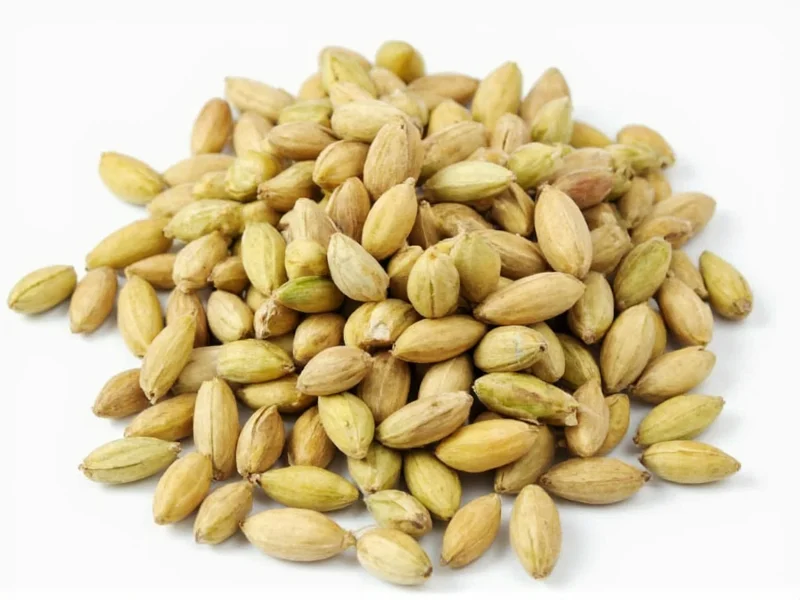Cardamom ranks among the world's most prized spices, second only to saffron in value. Understanding the distinction between cardamom seeds and pods transforms how you use this aromatic spice in your cooking. This comprehensive guide explores when to choose seeds versus pods, their flavor differences, and optimal usage techniques for professional-quality results.
Understanding Cardamom Anatomy
Cardamom grows inside small triangular pods that protect the precious black seeds within. The most common variety, green cardamom (Elettaria cardamomum), features pale green pods about 1 cm long. Each pod contains 8-10 tiny black seeds. Black cardamom (Amomum subulatum), less common in Western cuisine, has larger, smokier pods with more seeds.
The pod itself contains essential oils that contribute to cardamom's distinctive aroma. When intact, these oils release slowly during cooking, creating a more nuanced flavor profile. The seeds contain concentrated flavor compounds that deliver immediate intensity when crushed or ground.
Flavor Profile Comparison
Cardamom pods and seeds offer distinctly different flavor experiences:
| Characteristic | Cardamom Pods | Cardamom Seeds |
|---|---|---|
| Flavor Release | Slow, gradual infusion | Immediate, intense release |
| Aroma Complexity | More nuanced, floral notes | Sharper, more concentrated |
| Best Used In | Long-cooking dishes, infusions | Baking, spice blends, quick dishes |
| Shelf Life | 6-12 months when stored properly | 3-6 months after grinding |
Culinary Applications: When to Use Each Form
Cardamom pods shine in applications where slow flavor extraction matters. Indian chefs often toast whole pods before adding them to rice dishes like biryani, where they infuse the grains during cooking. Scandinavian bakers place pods in milk for cardamom buns, removing them before baking. For chai tea, whole pods simmer with other spices to create a balanced infusion.
Cardamom seeds excel when immediate flavor impact is needed. Grinding fresh seeds creates superior cardamom powder for Middle Eastern coffee spice mixes or Swedish kardemummabullar (cardamom buns). In Indian garam masala, freshly ground seeds blend seamlessly with other spices. For delicate desserts like cardamom shortbread cookies, seeds provide consistent flavor distribution.
Proper Storage Techniques
Maintaining cardamom's volatile oils requires careful storage. Whole pods retain freshness significantly longer than seeds. Store pods in airtight containers away from light and heat. Properly stored green cardamom pods maintain peak quality for 6-12 months. Black cardamom pods last even longer due to their denser structure.
Once you remove seeds from pods, their shelf life decreases dramatically. Ground cardamom loses potency within weeks. For best results when using cardamom seeds, grind only what you need immediately before use. If storing seeds separately, use dark glass containers and consume within 3 months for optimal flavor in cardamom seed storage.
Substitution Guidelines
Understanding cardamom pod to seed conversion prevents recipe failures. As a general rule:
- 1 cardamom pod = approximately 8-10 seeds
- 10-12 pods = 1.5 teaspoons seeds
- 1 teaspoon seeds = 1.25 teaspoons ground cardamom
When substituting whole pods for seeds in slow-cooked dishes, increase cooking time by 10-15 minutes to allow proper flavor extraction. For baking applications requiring cardamom seeds, never substitute whole pods—they won't distribute flavor evenly and create unpleasant texture.
Common Cardamom Mistakes to Avoid
Many home cooks make critical errors when using cardamom. Toasting whole pods before use enhances their flavor but requires careful attention—over-toasting creates bitterness. The optimal technique involves dry-heating pods in a skillet for 60-90 seconds until fragrant.
Another frequent mistake involves using pre-ground cardamom for delicate applications. Commercially ground cardamom often contains fillers and loses volatile compounds during processing. For authentic cardamom flavor in Scandinavian baking or Indian sweets, always grind your own seeds from fresh pods.
When working with cardamom pods in liquid-based recipes, remember to remove them before serving. Unlike bay leaves, cardamom pods don't soften during cooking and present a choking hazard if accidentally consumed.
Maximizing Flavor in Specific Cuisines
Different culinary traditions leverage cardamom seeds or pods in distinctive ways. In Indian cooking, green cardamom pods typically flavor rice dishes and meat curries, while black cardamom pods enhance robust meat preparations. Scandinavian bakers almost exclusively use freshly ground seeds for their characteristic cardamom buns.
For Middle Eastern coffee, the traditional preparation involves lightly crushing whole pods before adding to the brew. In Persian cuisine, cardamom seeds often appear in rice pudding and stews where immediate flavor integration matters. Understanding these cultural preferences helps you select the appropriate form for authentic results.
Can I substitute ground cardamom for whole pods in recipes?
Yes, but with adjustments. Use 1/4 teaspoon ground cardamom per pod, added later in cooking since ground spice loses potency faster. For long-simmering dishes, whole pods provide better flavor development than pre-ground spice.
How do I extract seeds from cardamom pods efficiently?
Place pods on a cutting board and gently crush with the flat side of a knife. The pods will split open, releasing the seeds. Alternatively, toast pods briefly then rub between your palms to separate seeds from husks. Discard the papery husks as they contribute little flavor.
Which form of cardamom works best for baking?
Freshly ground cardamom seeds generally work best for baking. The fine powder distributes evenly through doughs and batters, providing consistent flavor. Whole pods won't distribute flavor properly in baked goods and create unpleasant texture.
Does the color of cardamom pods affect flavor?
Yes significantly. Green cardamom pods offer citrusy, floral notes ideal for sweet and savory dishes. Black cardamom pods have a smoky, camphorous flavor better suited for hearty meat dishes. Never substitute one for the other in recipes requiring specific cardamom characteristics.
How can I tell if my cardamom has gone bad?
Fresh cardamom should have a strong, citrusy aroma. If pods feel light when shaken (indicating dried-out seeds) or show no fragrance when crushed, they've lost potency. Ground cardamom that doesn't leave a tingling sensation on your tongue has likely expired. Properly stored whole pods maintain quality significantly longer than seeds.











 浙公网安备
33010002000092号
浙公网安备
33010002000092号 浙B2-20120091-4
浙B2-20120091-4